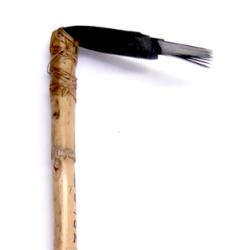Precision instruments like the sextant shown in Image 1, used by Captain James Cook on his third voyage to the Pacific, played a central role in encounters between Cook’s men and Polynesian islanders. Carried as tools of navigation, instruments could also be desirable objects of trade and appropriation.
When, in October 1777, a sextant was taken from the Resolution’s tent observatory, Cook entered into a heated confrontation with Borabora islanders. The Raiatean landowner Mai, who had returned to Polynesia from London on the Resolution, was a crucial go-between.
As Cook’s journal records, once Mai had re-secured the instrument, Cook exacted a brutal reparation for his prized object:
“The intercourse of trade, and friendly offices, was carried on between us and the natives, without being disturbed by any one accident, till the evening of the 22nd, when a man found means to get into Mr Bayly’s observatory, and to carry off a sextant, unobserved. … I went ashore, and got Omai [Mai] to apply to the Chiefs, to procure restitution. …
"Having employed Omai to examine the prisoner, with some difficulty he was brought to confess where he had laid the sextant [and] it was brought back unhurt. … as to the thief, he appearing to be a hardened scoundrel, I punished him with more severity than I had done any culprit before. Besides having his head and beard shaved, I ordered both his ears to be cut off, and then dismissed him.”(1)







